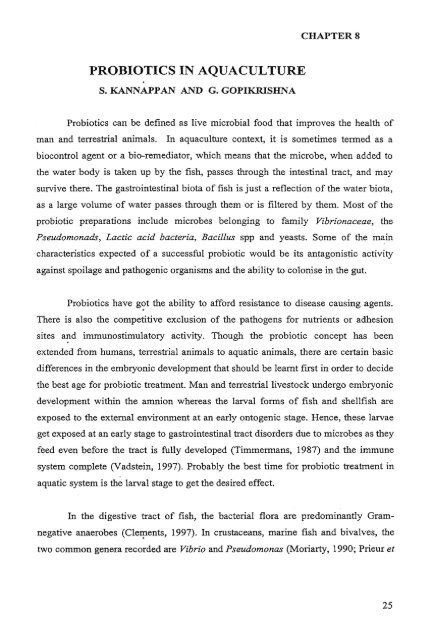Training Manual Application of Genetics and Biotechnology in ...
Training Manual Application of Genetics and Biotechnology in ...
Training Manual Application of Genetics and Biotechnology in ...
You also want an ePaper? Increase the reach of your titles
YUMPU automatically turns print PDFs into web optimized ePapers that Google loves.
CHAPTER 8<br />
PROBIOTICS IN AQUACULTURE<br />
S. KANNAPPAN AND G. GOPIKRISHNA<br />
Probiotics can be def<strong>in</strong>ed as live microbial food that improves the health <strong>of</strong><br />
man <strong>and</strong> terrestrial animals. In aquaculture context, it is sometimes termed as a<br />
biocontrol agent or a bio-remediator, which means that the microbe, when added to<br />
the water body is taken up by the fish, passes through the <strong>in</strong>test<strong>in</strong>al tract, <strong>and</strong> may<br />
survive there. The gastro<strong>in</strong>test<strong>in</strong>al biota <strong>of</strong> fish is just a reflection <strong>of</strong> the water biota,<br />
as a large volume <strong>of</strong> water passes through them or is filtered by them. Most <strong>of</strong> the<br />
probiotic preparations <strong>in</strong>clude microbes belong<strong>in</strong>g to family Vibrionaceae, the<br />
Pseudornonads, Lactic acid bacteria, Bacillus spp <strong>and</strong> yeasts. Some <strong>of</strong> the ma<strong>in</strong><br />
characteristics expected <strong>of</strong> a successful probiotic would be its antagonistic activity<br />
aga<strong>in</strong>st spoilage <strong>and</strong> pathogenic organisms <strong>and</strong> the ability to colonise <strong>in</strong> the gut.<br />
Probiotics have got the ability to afford resistance to disease caus<strong>in</strong>g agents.<br />
There is also the competitive exclusion <strong>of</strong> the pathogens for nutrients or adhesion<br />
sites <strong>and</strong> immunostimulatory activity. Though the probiotic concept has been<br />
extended from humans, terrestrial animals to aquatic animals, there are certa<strong>in</strong> basic<br />
differences <strong>in</strong> the embryonic development that should be learnt first <strong>in</strong> order to decide<br />
the best age for probiotic treatment. Man <strong>and</strong> terrestrial livestock undergo embryonic<br />
development with<strong>in</strong> the amnion whereas the larval forms <strong>of</strong> fish <strong>and</strong> shellfish are<br />
exposed to the external environment at an early ontogenic stage. Hence, these larvae<br />
get exposed at an early stage to gastro<strong>in</strong>test<strong>in</strong>al tract disorders due to microbes as they<br />
feed even before the tract is fully developed (Timmermans, 1987) <strong>and</strong> the immune<br />
system complete (Vadste<strong>in</strong>, 1997). Probably the best time for probiotic treatment <strong>in</strong><br />
aquatic system is the larval stage to get the desired effect.<br />
In the digestive tract <strong>of</strong> fish, the bacterial flora are predom<strong>in</strong>antly Gram-<br />
negative anaerobes (Clements, 1997). In crustaceans, mar<strong>in</strong>e fish <strong>and</strong> bivalves, the<br />
two common genera recorded are Yibrio <strong>and</strong> Pseudomonas (Moriarty, 1990; Prieur et

















